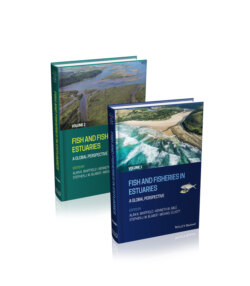Читать книгу Fish and Fisheries in Estuaries - Группа авторов - Страница 27
2.4 Fish guilds and functional groups
ОглавлениеMany studies have dealt with the taxonomic entities within estuaries, i.e. the species composition of fish assemblages and their seasonal and spatial variation (e.g. Potter et al. 1997, Yáñez‐Arancibia et al. 1988, Marshall & Elliott 1998, Nordlie 2003, Albaret et al. 2004, Ecoutin et al. 2005, Able & Fahay 2010). However, with increasing knowledge of the fish species occupying estuaries, scientists were then able to group them according to their life history patterns (Figure 2.10).
Several studies have concentrated on a functional analysis of community structure in which the species present are assigned to groupings or guilds, each of which denotes certain attributes. For example, Albaret (1999) used bioecological categories, essentially guilds, to define and compare the fundamental estuarine fish community. Thus guilds, or equivalent terminology, have been used to provide information on the functioning, hierarchical structure and connectivity of estuaries, and to simplify our ecological understanding of complex ecosystems (Elliott & Dewailly 1995, Garrison & Link 2000, Lobry et al. 2003, Franco et al. 2006, Potter et al. 2016, Nickerson et al. 2018).
Figure 2.9 Ordinations (nMDS) derived from (a) presence/absence and (b) abundance of fish species from the nearshore waters of 14 south‐western Australian estuaries (after Tweedley et al. 2017). Stack bar graphs of the number and percentage contribution of species (e–f) and density and percentage contribution (g–j) of fish by both EUFG category and guild. EUFG: MS = marine straggler, MEO = marine estuarine‐opportunist, E&M = estuarine & marine, E = solely estuarine, E&F = estuarine & freshwater, SC = semi‐catadromous, SA = semi‐anadromous, FEO = freshwater estuarine‐opportunist, FS = freshwater straggler. Estuaries: P = Peel‐Harvey, Sw = Swan‐Canning, Bw = Blackwood, L = Leschenault, O = Oyster, M = Moore, V = Vasse‐Wonnerup, Br = Broke, I = Irwin, W = Wilson, We = Wellstead, St = Stokes, H = Hamersley, C = Culham. Estuary type: PO = permanently open, IO = intermittently open, SO = seasonally open, NC = normally closed.
The concept of guilds was first developed for fishes inhabiting estuaries in the early classical works by McHugh (1967), Cronin & Mansueti (1971), Perkins (1974), Haedrich (1983) and Wallace et al. (1984), all of whom separated the components of the estuarine nekton into ecological groupings. The concept was also used by de Sylva (1975) and Whitfield (1980b) who defined groupings of estuarine fishes based on their feeding preferences and food web structure. This type of analysis was then extended to include descriptions of the migration, reproduction and habitat preferences of species (e.g. Potter et al. 1990, Whitfield 1990, Elliott & Dewailly 1995).
Prior to a review by Elliott et al. (2007), the approach to classifying fish into categories and guilds in terms of the way they use estuaries varied considerably according to individual biogeographic areas and types of estuaries, as well as the variety of available terms. These authors developed a classification scheme that is a logical extension of previous conceptual models and which focusses especially on a revision and standardisation of previous categorizations. It also draws out those cases where the classification of a particular guild has to be adapted to meet differences between the fish faunas in very different regions (e.g. temperate versus tropical) or where new information necessitates the creation of additional categories or a revision of existing categories.
Figure 2.10 Life cycle guilds of estuary‐associated fishes, based on the review by Potter et al. (2015a); (a) marine straggler, (b) marine estuarine‐opportunist/estuarine‐dependent, (c) solely estuarine, (d) estuarine & marine, (e) estuarine & freshwater, (f) estuarine migrant, (g) anadromous, (h) semi‐anadromous, (i) catadromous, (j) semi‐catadromous, (k) amphidromous, (l) freshwater straggler, (m) freshwater estuarine‐opportunist.
Subsequently, Potter et al. (2015a) updated the Estuarine Use Functional Group (EUFG) component of Elliott et al. (2007) and thus it now includes four broad ‘umbrella’ categories: marine, estuarine, diadromous and freshwater (Table 2.2). Each of these categories contains two or more guilds, which represent characteristics associated with the locations of spawning, feeding and/or refuge and, in some cases, involve migratory movements between estuaries and other ecosystems. The Feeding Mode Functional Group (FMFG), which defines the primary method of feeding used by a given species, is presented in Table 2.3 and the Reproductive Mode Functional Group (RMFG), which indicates how and, in some cases, where an estuarine species reproduces, is outlined in Table 2.4 (Elliott et al. 2007).
Within each of the above major categories, subcategories have been defined and, where possible, examples given that illustrate the use of that mode by fishes from estuaries in different biogeographical regions (Elliott et al. 2007, Potter et al. 2015a). In this way, the approach can be used to show similarities or differences in the global estuarine fish community structure, based primarily on the functional guilds encountered.
